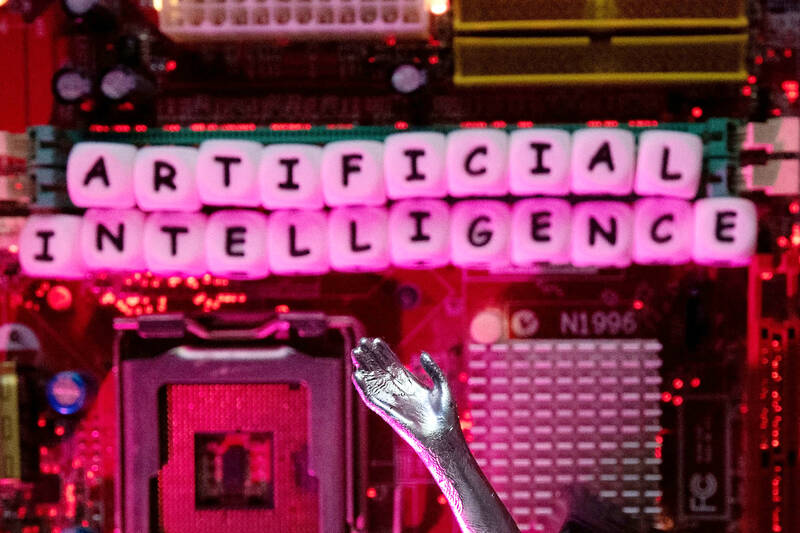MAKE AI WORK SMARTER
Asking ChatGPT to write your emails is so two years ago.
Generative AI tools are now going beyond the basic text-prompt phase. Take Google’s NotebookLM, an experimental “AI research assistant” that lets you upload not just text but also videos, links and PDFs. It will provide a summary of the content, answer questions about it, and even make a podcast-like “AI overview” if you want it to — all while organizing your original sources and notes.

Photo: Reuters
As AI tools advance, expect more features like this to be baked into everyday software. All the usual caveats of using AI apply: the responsibility for factchecking lies with you.
BREAK FREE OF THE ALGORITHM
If you’re stuck in a feedback loop of samey music or TV recommendations, go for a refresh. Some platforms, such as Netflix, let you delete your viewing history, which will help clear the slate (select “hide all” under “viewing activity” for a do-over).
Spotify is harder to crack: you’ll need to train it into offering a broader selection by diversifying your listening. Choose playlists that focus specifically on new music, or go old school and ask friends for their tips. Use the “private session” mode or select “exclude from your taste profile” to keep your guilty pleasures (or your kids’ nursery rhymes) from infecting future recommendations.
LEARN TO SPOT AI VIDEO
Manipulated videos, or “deepfakes,” might already be old hat, but you can expect to see more entirely AI-generated videos as text-to-video tools enter the mainstream.
OpenAI’s Sora and Meta’s Movie Gen are continuing to be developed, with impressive (or concerning, depending on your stance) results. Look for watermarks that show a video is AI-generated, and watch out for telltale mistakes, such as errors in anatomy or weird physics. Most importantly, use context clues: if something seems particularly shocking, unlikely, or out of place, be on guard.
LOOK UP, LOOK OUT, MAKE A BACKUP
So-called “snatch thefts” are at a high, with the equivalent of more than 200 such robberies occurring across England and Wales each day. Thieves, often on bikes or mopeds, grab phones to sell overseas. There’s not much you can do in the moment, but you can slightly soften the impact by making sure anything important on your phone is backed up. Many manufacturers offer to automatically sync all your files to a cloud service; alternatively, you can find options for specific media in the relevant phone or app settings.
TACKLE THE TECH DRAWER OF DOOM
Everyone has one: the drawer (or cupboard or box) of discarded devices, broken electronics and tangled cables hoarding valuable metals. Make this the year you reclaim the space from your unwanted e-waste. If your old stuff is in good nick, you can also try selling or donating it; remember to wipe personal data from laptops and phones by doing a factory reset or removing the hard drive.

May 26 to June 1 When the Qing Dynasty first took control over many parts of Taiwan in 1684, it roughly continued the Kingdom of Tungning’s administrative borders (see below), setting up one prefecture and three counties. The actual area of control covered today’s Chiayi, Tainan and Kaohsiung. The administrative center was in Taiwan Prefecture, in today’s Tainan. But as Han settlement expanded and due to rebellions and other international incidents, the administrative units became more complex. By the time Taiwan became a province of the Qing in 1887, there were three prefectures, eleven counties, three subprefectures and one directly-administered prefecture, with

President William Lai (賴清德) yesterday delivered an address marking the first anniversary of his presidency. In the speech, Lai affirmed Taiwan’s global role in technology, trade and security. He announced economic and national security initiatives, and emphasized democratic values and cross-party cooperation. The following is the full text of his speech: Yesterday, outside of Beida Elementary School in New Taipei City’s Sanxia District (三峽), there was a major traffic accident that, sadly, claimed several lives and resulted in multiple injuries. The Executive Yuan immediately formed a task force, and last night I personally visited the victims in hospital. Central government agencies and the

Among Thailand’s Chinese Nationalist Party (KMT) villages, a certain rivalry exists between Arunothai, the largest of these villages, and Mae Salong, which is currently the most prosperous. Historically, the rivalry stems from a split in KMT military factions in the early 1960s, which divided command and opium territories after Chiang Kai-shek (蔣介石) cut off open support in 1961 due to international pressure (see part two, “The KMT opium lords of the Golden Triangle,” on May 20). But today this rivalry manifests as a different kind of split, with Arunothai leading a pro-China faction and Mae Salong staunchly aligned to Taiwan.

As with most of northern Thailand’s Chinese Nationalist Party (KMT) settlements, the village of Arunothai was only given a Thai name once the Thai government began in the 1970s to assert control over the border region and initiate a decades-long process of political integration. The village’s original name, bestowed by its Yunnanese founders when they first settled the valley in the late 1960s, was a Chinese name, Dagudi (大谷地), which literally translates as “a place for threshing rice.” At that time, these village founders did not know how permanent their settlement would be. Most of Arunothai’s first generation were soldiers